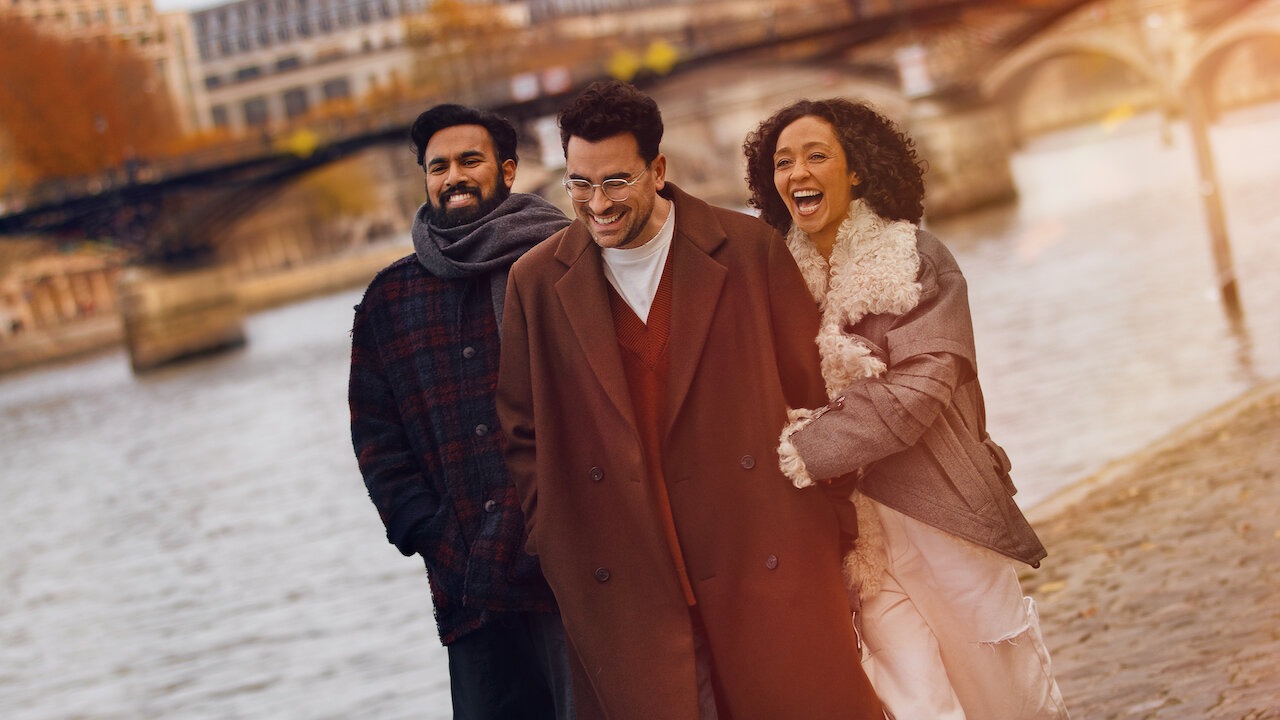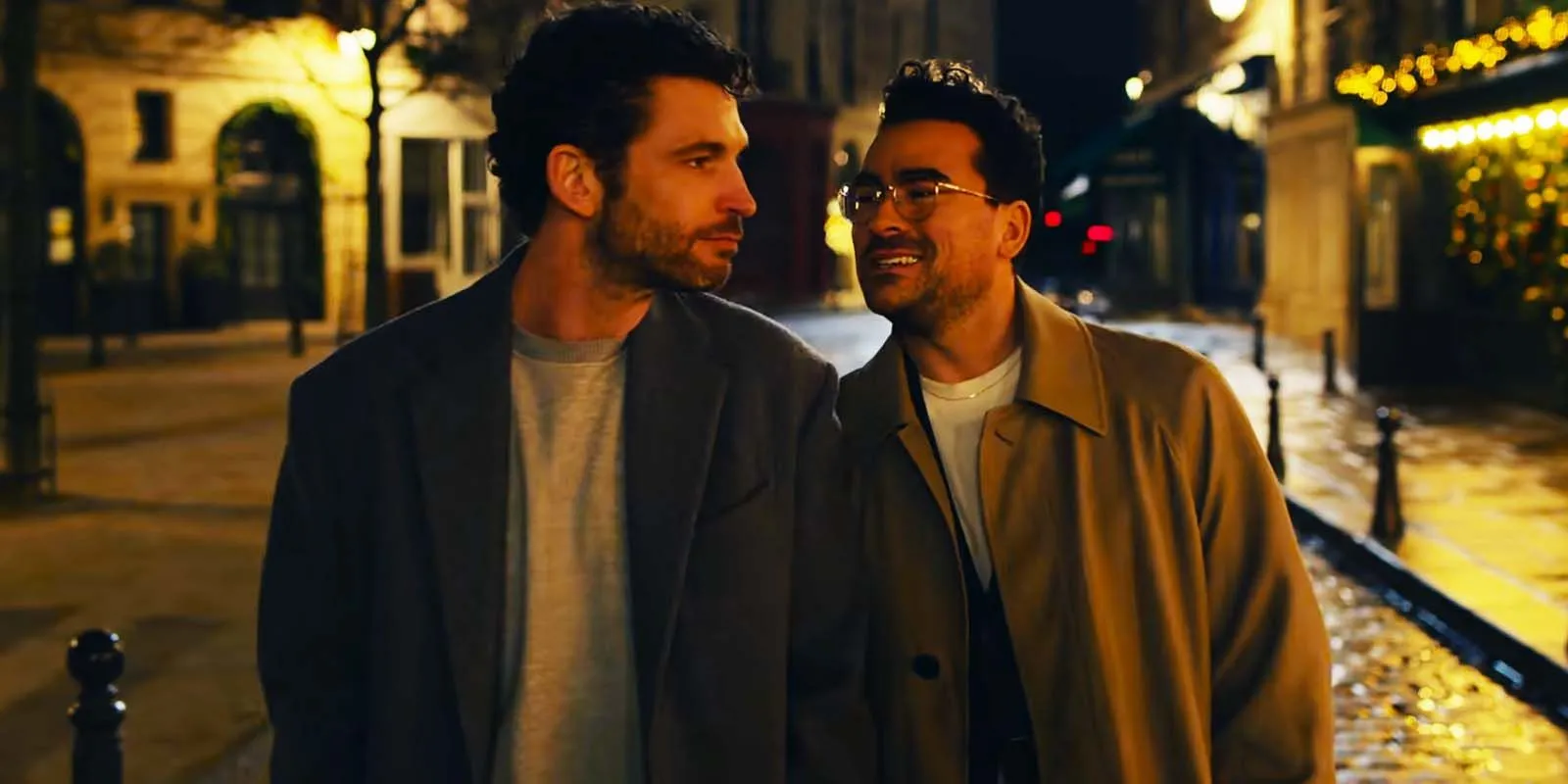Rather than closing the book on Marc’s story, Good Grief presents an ending that feels like a new beginning, wrapping up his emotional journey with a strong sense of hope. The film marks the first project in Dan Levy’s multi-project deal with Netflix.
It follows Marc (played by Dan Levy, who also wrote and directed the film) as he struggles with the loss of his husband, Oliver (Luke Evans), while uncovering secrets Oliver kept from him. Throughout this challenging period, his close friends Sophie (Ruth Negga) and Thomas (Himesh Patel) remain steadfast by his side.

They support him even as they deal with their struggles. Their trip to Paris timed with the anniversary of Oliver’s death, serves as a backdrop for all their unresolved emotions to surface.
As one of the first movies to hit Netflix in January, Good Grief presents Marc’s emotional turmoil as he stumbles upon Oliver’s secret property in Paris, seemingly shared with another romantic partner.
The film’s conclusion ties into the end of Marc, Sophie, and Thomas’ Paris trip, allowing each of them to confront personal issues and the tensions within their friendship. With Oliver’s hidden life coming to light and Luca’s unexpected arrival stirring more emotions, the story pushes Marc to face his grief fully.
Instead of running from it, he channels his emotions into painting—something he had been unable to do for years—signifying his acceptance of love and loss.
Why Marc Moved To Margate
He Wasn’t Running Away, As Imelda Assumed
One of the first decisions Marc made upon returning from Paris was selling the London home he once shared with Oliver. Though his financial advisor, Imelda, cautioned against doing so to avoid running from the past, the film makes it clear that Marc’s reason for selling had nothing to do with escaping memories.
That house symbolized the life he built with Oliver, and parting with it wasn’t about forgetting but about holding on to those memories in a way that allowed him to heal. Moving to Margate gave him the space to paint again, and his new work reflected both his time in London and his life with Oliver.
Why Marc Decides To Paint Again
Expressing Himself Through Art Becomes His Way Of Processing Loss
Despite only recently meeting Marc, Theo wasted no time in bringing up his artwork upon discovering that Marc was a painter. From the start of Good Grief, painting had been a sore subject for Marc, with Thomas being one of the few people who knew he had once done more than illustrate children’s books.
However, it was Theo’s unexpected connection with Marc that brought to light an unspoken truth—Marc had been carrying guilt from his mother’s death for years. He had spent so much time engrossed in his relationship with Oliver that he failed to be there for her in her final days.
Rather than confronting his grief, Marc had distanced himself from anything associated with his mother to avoid the pain. Realizing he had done the same thing after Oliver’s death made him determined not to repeat the cycle.
Forcing himself to start painting again became his way of embracing grief rather than running from it. Letting go of his emotions would have meant letting go of everything Oliver brought into his life, and picking up a paintbrush again allowed him to hold on to those memories in a meaningful way.
How Marc, Sophie, and Thomas’ Trip To Paris Helped Them Face Their Issues
They Had Long Avoided Difficult Conversations
Among all the characters in Good Grief, Sophie and Thomas are the ones who stand by Marc the most during his first year without Oliver. They prioritized his well-being, often pushing aside their struggles to ensure he didn’t drown in his grief.
However, constantly being there for Marc made it easier for them to neglect their problems, and the trip to Paris laid bare Sophie’s deep-seated fear of commitment to Terrance, as well as Thomas’ worries about always being seen as someone’s partner rather than the person for someone.
Their friendship had a long-standing flaw—none of them addressed issues directly, preferring to ignore uncomfortable truths. Sophie’s speech during the dinner marking Oliver’s death anniversary exposed this, forcing them to finally confront everything left unsaid.
Without that moment, Marc would never have admitted his pain over Oliver considering leaving him before his passing, Thomas wouldn’t have acknowledged his fears about never finding a lasting relationship, and Sophie wouldn’t have faced her pattern of avoiding commitment.
Though the trip began as an act of support for Marc, it gave all three of them clarity and a space to be heard.
How Marc and Luca’s Conversation Helped Him Let Go Of His Anger Toward Oliver
Instead Of Holding Onto Resentment, He Chose To See The Bigger Picture
Meeting Luca was never something Marc had intended, despite knowing it was a possibility since Oliver’s Paris apartment was shared exclusively with him. However, after a deep conversation with Sophie and Thomas, Marc found the courage to confront Luca, leading to a moment of understanding between them.
Marc admitted that anger had been an easier emotion to hold onto than grief, as focusing on Oliver’s betrayal was less painful than facing the void his absence left behind. Their honest discussion allowed Marc to let go of his most negative impulses.
Instead of blaming Luca or resenting Oliver, he chose to acknowledge their shared experiences. This change in perspective helped him move forward, no longer consumed by resentment but rather open to seeing things with greater clarity.
Why Meeting Theo Allowed Marc To Process His Grief More Freely
Unlike With Sophie & Thomas, There Were No Preexisting Barriers
Hints from Good Grief’s trailer suggest that Marc might find love again in Paris, but his connection with Theo turns out to be more than just a potential romance.
While the film leaves their relationship open-ended, with one of Marc’s paintings depicting Theo in front of Monet’s Water Lilies, Theo’s presence is crucial in a different way. His role in Marc’s story wasn’t about romance—it was about helping Marc go through his grief.
Since Theo had no prior history with Marc, there were no lingering issues or unspoken expectations between them. Unlike Sophie and Thomas, whose relationships with Marc carried years of emotional weight, Theo offered a fresh perspective.
His honesty encouraged Marc to embrace every emotion tied to his grief, rather than suppress it. Through their connection, Marc found the courage to fully process his feelings, even rekindling his passion for painting as a way to express them.
What Good Grief’s Ending Means

By Returning To Painting, Marc Fully Embraces His Emotions
Before setting off for his new chapter in Margate, Imelda warned Marc about the danger of shutting down emotionally to avoid pain. She knew him well enough to recognize that this was something he might do.
If Marc at the beginning of Good Grief had been faced with such a warning, he likely would have fallen into that exact pattern. However, his trip to Paris forced him to confront difficult truths—about himself, about his friendship with Sophie and Thomas, and his marriage to Oliver.
Rather than letting the pain consume him, he learned that feeling was necessary for healing. The film shows clear growth in Marc’s character. Even when Oliver was alive, he had avoided painting because it would have forced him to confront his mother’s loss.
But through his interactions with Theo, his conversation with Luca, and the hard truths revealed through Sophie and Thomas, he finally reached a point where he was strong enough to embrace his grief.
Moving to Margate at the film’s end marked both the completion of one chapter and the start of another—one where painting would no longer be something he avoided but rather something that allowed him to heal.



